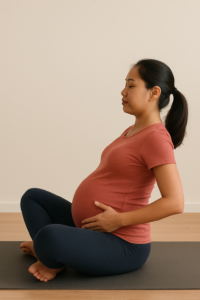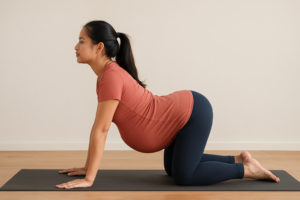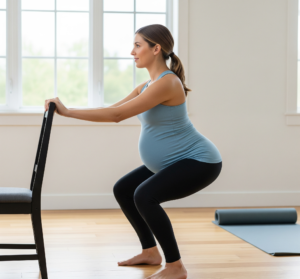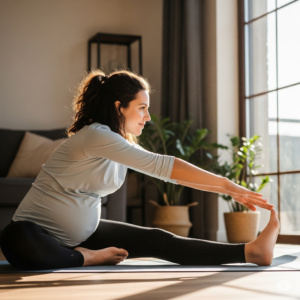Pregnancy is one of the most transformative journeys in a woman’s life. While it brings immense joy, it also comes with physical and emotional changes that can sometimes feel overwhelming. From backaches and fatigue to shifts in posture and balance, the body adapts in incredible ways to support the growing baby. Physiotherapy exercises, when performed safely, can help ease these discomforts, improve strength, and prepare the body for childbirth — all while keeping both mother and baby safe.
The key is to follow a trimester-specific exercise plan, as each stage of pregnancy has its own needs and precautions. Below is a simple, safe, and effective guide to help you stay active throughout all three trimesters.
First Trimester (Weeks 1–12)
The first trimester is often marked by fatigue, morning sickness, and major hormonal changes. During this stage, many expectant mothers may not feel up for an intense workout. The focus should be on maintaining energy, reducing stress, and laying the foundation for a stronger body as pregnancy progresses.
Safe Exercises:
Pelvic Tilts: Gentle movements that strengthen the abdominal and lower back muscles while easing tension. These are especially helpful in preparing the body for future postural changes.

Cat-Cow Stretch: A yoga-inspired stretch that improves spinal flexibility and relieves stiffness in the back.

Walking: Low-impact cardio that keeps circulation flowing, helps with mood, and combats fatigue.

Breathing Exercises: Controlled breathing promotes relaxation, enhances oxygen intake, and reduces stress.
Caution: Avoid high-impact activities and ensure you do not overheat, as excessive heat can be harmful during this stage.

Second Trimester (Weeks 13–27)
For many women, the second trimester is considered the most comfortable phase. Energy levels often return, and morning sickness may ease. This is the ideal time to be consistent with exercise, as the body feels stronger and more capable of movement. The main goals during this period are to maintain good posture, strengthen muscles, and support balance as the belly grows.
Safe Exercises:
Seated Ball Exercises: Sitting on an exercise ball while performing gentle movements helps strengthen the pelvic floor and improve stability.

Side-Lying Leg Lifts: A safe way to build hip and thigh strength without straining the back.

Modified Squats: Strengthen pelvic and leg muscles, preparing the body for delivery.

Flexibility Training: Gentle stretching routines improve flexibility, ease tension, and reduce stress.

Caution: Avoid lying flat on your back for extended periods, as it can restrict blood flow to both mother and baby.
Third Trimester (Weeks 28–40)
The final trimester brings the most physical challenges. The growing belly increases pressure on the spine, hips, and joints, making comfort and relaxation top priorities. Exercises should now focus on preparing for labor, improving circulation, and relieving muscle stiffness.
Safe Exercises:
Pelvic Floor (Kegel) Exercises: Strengthen muscles that play a vital role in childbirth and recovery after delivery.

Gentle Stretching: Helps release tension in the hips, lower back, and legs, which often carry the extra weight.

Walking or Light Swimming: Both are excellent low-impact ways to maintain circulation, reduce swelling, and support overall mobility.

Relaxation & Breathing Drills: These exercises calm the mind, lower stress, and help expectant mothers prepare mentally and physically for labor.

Caution: Avoid exercises that put you at risk of losing balance or involve sudden, jerky movements.
Key Benefits of Physiotherapy During Pregnancy
Regular physiotherapy-based exercises, when done correctly, offer more than just physical comfort. They provide holistic benefits that make the pregnancy journey smoother and more enjoyable.
Reduces back and pelvic pain by strengthening supporting muscles.
Improves posture and balance, reducing the risk of falls and discomfort.
Enhances flexibility and strength, helping the body adapt to changing weight distribution.
Supports smoother labor and recovery, as stronger muscles can assist during delivery and speed up postpartum healing.
Promotes mental relaxation, reducing anxiety and boosting overall well-being.
Final Note
Every pregnancy is unique, and so are the needs of every expecting mother. While physiotherapy exercises are generally safe and beneficial, it’s essential to consult your physiotherapist or healthcare provider before beginning or modifying your exercise routine. They can guide you with personalized adjustments to suit your body’s condition, ensuring both your safety and your baby’s.
Pregnancy should be embraced as a time to nurture yourself as much as your little one. By following safe, trimester-specific physiotherapy exercises, you can ease discomfort, stay active, and prepare your body for the incredible experience of childbirth.
want to be physical therapist-check physioneeds academy



